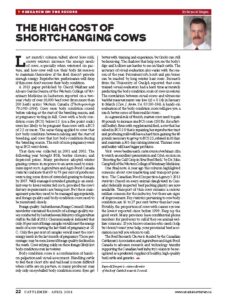The High Cost of Shortchanging Cows
This article written by Dr. Reynold Bergen, BCRC Science Director, originally appeared in the April 2014 issue of Canadian Cattlemen magazine and is reprinted on the BCRC Blog with permission of the publisher.
Last month’s column talked about how cold, snowy winters increase the energy needs of cows, especially when wintered on pasture, and how cows will use their body fat reserves to maintain themselves if the feed doesn’t provide enough energy. Reproductive performance will drop if thin cows don’t recover their body condition.
A 2013 paper published by the Cheryl Waldner and Alvaro García Guerra of the Western College of Veterinary Medicine in Saskatoon reported on a two-year study of over 30,000 beef cows from more than 200 herds across Western Canada (Theriogenology 79:1083-1094). Cows were body condition scored before calving, at the start of the breeding season, and at pregnancy testing in fall. Cows with a body condition score (BCS) below 2.5 (on a 5 point scale) were less likely to be pregnant than cows with a BCS of 2.5 or more. The same thing applied to cows that lost body condition between calving and the start of breeding, and cows that lost body condition during the breeding season. The risk of non-pregnancy went up as BCS went down.
That data was collected in 2001 and 2002. The following year brought BSE, border closures, and depressed prices. Many producers adopted winter grazing systems in response to an acute need to minimize input costs. Agriculture and Agri-Food Canada statistics indicate that 69% to 79% of producers were using some form of extended grazing technique by 2007. Well-managed extended grazing is an excellent way to lower winter fed costs, provided the cow’s dietary requirements are being met. But these management practices need to be managed appropriately, and forage quality and body condition score need to be monitored closely.
Forage quality: Saskatchewan Forage Council’s March newsletter contained the results of a forage quality survey conducted by Saskatchewan Ministry of Agriculture staff in the fall of 2013. Chemical analysis indicated that only 38% of forage samples would meet the energy needs of a cow starting the last third of pregnancy at -25oC. Only 5% of samples would meet the cow’s energy needs in the last month of pregnancy. Those percentages may be even lower if forage quality declined in the swath. Cows relying solely on these forages likely lost body condition score last winter.
Body condition score is a combination of hands-on palpation and visual assessment. Handling cattle to feel their short ribs and tail head is more difficult when cattle are on pasture, so many producers may rely only on eyeballed body condition scores. Eyes get better with training and experience, but looks can still be deceiving. The shadows that help you see the body’s dips and hollows are harder to see on black cattle. The accuracy of visual evaluation also varies with the season of the year. Prominent rib, hook and pin bones can be masked by long winter hair coats. Research from the University of Guelph reported that even trained visual evaluators had a hard time accurately predicting the body condition score of cows in winter. The correlation between visual scores and ultrasonic backfat measurements was low (r2 = 0.14) in January to March (Can. J. Anim. Sci. 83:593-596). A hands-on evaluation of the body condition score will give you a much better sense of their real fat stores.
As a general rule of thumb, mature cows need to gain 80 lbs to increase one BCS score (150 lbs for a first calf heifer). Even with supplemental feed, a cow that has calved in BCS 2, is repairing her reproductive tract and producing milk will have a hard time gaining the 40lbs necessary needed to get up to BCS 2.5, rebreed in 83 days and maintain a 365 day calving interval. Thinner cows and heifers will have bigger problems.
Visit beefresearch.ca/resources to watch an excellent presentation and Q&A session on “Boosting the Calf Crop in Your Beef Herd” by Dr. John Campbell of the Western College of Veterinary Medicine.
One final note. A year ago this column highlighted concerns about cow marketing and transport practices. The Canadian Food Inspection Agency’s 2013 statistics (based on every animal slaughtered in Canada’s federally inspected beef packing plants) are now available. Transport of thin cows remains a serious welfare concern for the industry, but there are signs of improvement. Key statistics pertaining to cow body condition are 16 to 27% better than last year. Notably, the proportion of cows with cancer eye was the lowest reported since before 1999. Keep up the good work. Many provinces have confidential phone numbers for producers to call if they see animal welfare concerns. If you know someone who needs help but doesn’t want your help, your provincial beef association can tell you whom to call.
Click here to subscribe to the BCRC Blog and receive email notifications when new content is posted.
The sharing or reprinting of BCRC Blog articles is typically welcome and encouraged, however this article requires permission of the original publisher.
We welcome your questions, comments and suggestions. Contact us directly or generate public discussion by posting your thoughts below.
